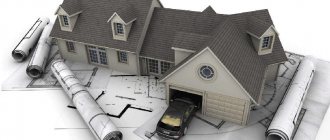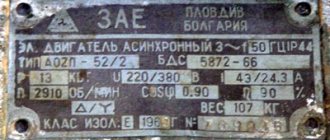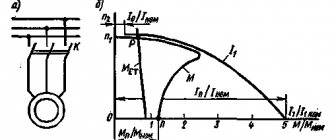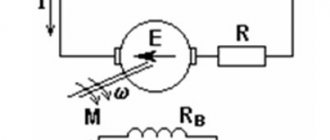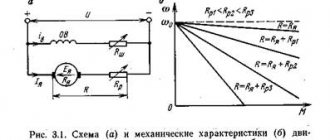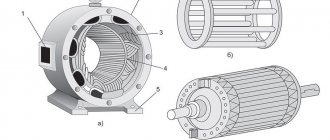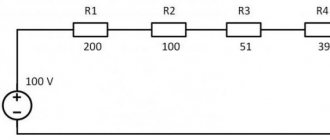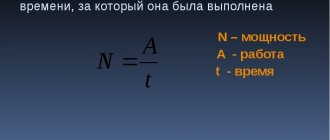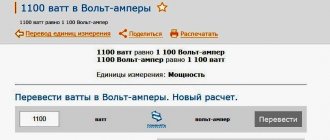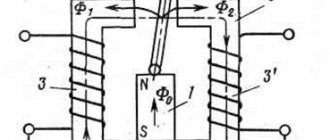Electric motor power concept
Power is perhaps the most important parameter when choosing an electric motor. Traditionally, it is indicated in kilowatts (kW), for imported models - in kilowatts and horsepower (hp, HP, Horse Power). For reference: 1 hp. approximately equal to 0.75 kW.
The engine nameplate indicates the rated net (output mechanical) power
. This is the power that the engine can deliver to a mechanical load with the stated parameters without overheating. In the formulas, the rated mechanical power is denoted by P2.
Electrical (consumption) power
motor P1 is always greater than the output P2, since there are losses in any energy conversion device. The main losses in an electric motor are mechanical, caused by friction. As you know from a physics course, losses in any device are determined through efficiency (ƞ), which is always less than 100%. In this case, the formula is valid:
Р2 = Р1 · ƞ
The efficiency in engines depends on the rated power - for low-power models it can be less than 0.75, for powerful ones it exceeds 0.95. The above formula is valid for active power consumption. But, since the electric motor is an active-reactive load, to calculate the total power consumption S
(taking into account the reactive component) it is necessary to take into account reactive losses. The reactive component is expressed in terms of power factor (cosϕ). Taking this into account, the formula for the rated engine power looks like this:
Р2 = Р1 · ƞ = S · ƞ · cosϕ
Mechanical power
Details
Who will lift the entire load to a height faster, a person or a crane? Which lifting mechanism has more power?
Power characterizes the speed at which work is done.
Power (N) is a physical quantity equal to the ratio of work A to the time period t during which this work was performed.
Power shows how much work is done per unit of time.
In the International System of Units (SI), the unit of power is called the Watt (W) in honor of the English inventor James Watt (Watt), who built the first steam engine.
[N] = W = J/s
1 W = 1 J/s
1 Watt is equal to the power of a force that does 1 J of work in 1 second or,
when a load weighing 100g is lifted to a height of 1m in 1 second.
James Watt himself (1736 - 1819) used another unit of power - horsepower (1 hp), which he introduced in order to compare the performance of a steam engine and a horse.
1 hp = 735 W
However, in real life, the average horse has about 1/2 hp, although, of course, horses are different.
“Living engines” can briefly increase their power several times.
When running and jumping, a horse can increase its power up to ten times or more.
Making a jump to a height of 1 m, a horse weighing 500 kg develops a power equal to 5,000 W = 6.8 hp.
It is believed that the average power of a person during quiet walking is approximately 0.1 hp. i.e. 70 – 90W.
Like a horse, a person can develop power many times greater when running and jumping.
LOOK HERE………. look
It turns out that the most powerful source of mechanical energy is a firearm!
Using a cannon, you can throw a cannonball weighing 900 kg at a speed of 500 m/s, developing about 110,000,000 J of work in 0.01 seconds. This work is equivalent to lifting 75 tons of cargo to the top of the Cheops pyramid (height 150m).
The power of the cannon shot will be 11,000,000,000 W = 15,000,000 hp.
The force of tension in a person's muscles is approximately equal to the force of gravity acting on him. When 2 people of equal weight climb a ladder to the same height, but at different speeds, which of them develops more power?
DON'T FORGET THAT
– this formula is valid for uniform motion with constant speed and in the case of variable motion for average speed.
It follows that
From the above formulas it is clear that with constant engine power, the speed of movement is inversely proportional to the traction force and vice versa.
This is the basis for the operating principle of the gearbox (gearbox) of various vehicles.
WHAT ARE YOU GOING WITH WITH THE “SUMMARY”?
Let's check it now!
1. Do the engines of a tram car develop the same power when it moves at the same speed without passengers and with passengers?
Answer: Pri nalitshii passashiriv sila tjashesti (ves) vagona bolshe, uvelitshivaetsja sila trenia, ravnaja v dannom slutshae sile tjagi, vosrastaet motshnost, uvelitshivaetsja rashod electroenergii.
2. Why does a ship with cargo move slower than without it? After all, the engine power in both cases is the same.
Answer: S uvelitsheniem nagruski korabl bolshe pogrushaetsja v wodu. eto uvelitshivaet silu soprotivlenija wodi dvisheniu korablja, tshto privodit k potere skorosti.
3. The tractor has three speeds: 3.08; 4.18 and 5.95 km/h. At what speed will it develop greater traction force on the hook with the same power?
Answer:
If you figured it out on your own, then you are WELL DONE! What if you looked at the answers? Maybe tired? Never mind, the holidays are coming!
Engine power and heating
The rated power is usually specified for an ambient temperature of 40°C and is limited by the maximum heating temperature. Since the weakest point in a motor in terms of overheating is insulation, power is limited by the insulation class of the stator winding. For example, for the most common insulation class F, the permissible heating is 155°C at an ambient temperature of 40°C.
The documentation for electric motors provides data that shows that the rated power of the motor drops as the ambient temperature rises. On the other hand, with proper cooling, engines can operate at higher than rated power for a long time.
We have looked at the power consumption and output, but it should be said that the actual operating power consumption P
(motor shaft power at a given moment) should always be less than rated:
R 2 1
This is necessary to prevent engine overheating and to have an overload reserve. Short-term overloads are permissible, but they are limited primarily by engine heating. It is also advisable to install motor overload protection not based on the rated current (which is directly proportional to power), but based on the actual operating current.
Modern manufacturers mainly produce engines from a number of ratings: 1.5, 2.2, 5.5, 7.5, 11, 15, 18.5, 22 kW, etc.
What is an electric motor?
An electric motor is a device that converts electrical energy into mechanical energy. The operation of most units depends on the interaction of the magnetic field with the rotor winding, which is expressed in its rotation. They operate from DC or AC power sources. The power supply can be a battery, an inverter or a power outlet. In some cases, the engine works in reverse, that is, it converts mechanical energy into electrical energy. Such installations are widely used in power plants powered by air or water flow.
Electric motors are classified by type of power source, internal design, application and power. Also, AC drives may have special brushes. They operate on single-phase, two-phase or three-phase voltage and are air or liquid cooled. AC motor power formula
where P is power, U is voltage, I is current.
General purpose drives with their own sizes and characteristics are used in industry. The largest engines with a power of more than 100 Megawatts are used in the power plants of ships, compressor and pumping stations. Smaller sizes are used in household appliances, such as a vacuum cleaner or fan.
Engine power calculation based on measurements
In practice, the motor power can be calculated primarily from the operating current. The current is measured by current clamps in the maximum operating mode, when the operating power approaches the rated power. In this case, the temperature of the motor housing can exceed 100 °C, depending on the heat resistance class of the insulation.
We substitute the measured current into the formula to calculate the real mechanical power
on the shaft:
P = 1.73 U I cosϕ ƞ
, Where
- U – supply voltage (380 or 220 V, depending on the connection diagram - “star” or “delta”),
- I – measured current,
- cosϕ and ƞ – power factor and efficiency, the values of which can be taken equal to 0.8 for low-power motors (less than 5.5 kW) or 0.9 for motors with a power of more than 15 kW.
If you need to find the rated power
engine, then the resulting result is rounded up to the nearest value from the range of denominations.
P2 > P
If you need to calculate the active power consumption
, we use the following formula:
P1 = 1.73 U I ƞ
It is the active power that electricity meters measure. In industry, additional equipment is used to measure reactive (and apparent power S). With this method, you can not use the above formula, but do it in a simpler way - if the motor is connected to a “star”, we multiply the measured current value by 2 and get the approximate power in kW.
Three-phase motor power formula
In order to determine engine power, the formula looks like this:
P=√3*U*I*cosϕ*η.
Ingredients of the formula:
- Un – rated voltage;
- Iн – rated current of the electric motor (according to the passport);
- Cosϕ – power factor (0.75-0.9);
- η – efficiency (0.7-0.85).
If the value of In is unknown, it must be found using the appropriate formula.
Asynchronous motors used for three-phase networks are the most stable and reliable machines. However, the AC frequency limit of 50 Hz does not allow them to reach rotation speeds of more than 3000 rpm. Therefore, universal commutator DFCs are an effective solution for mechanical processes that require the motor to be able to rotate the shaft at a higher frequency.
Power calculation using an electricity meter
This method is simple and does not require additional tools or knowledge. It is enough to connect the motor through a meter (three-phase metering unit) and find out the difference in readings over a strictly defined time. For example, when the engine is running for an hour, the difference in the meter readings will be numerically equal to the active power of the engine (P1). But to get the rated power P2, you need to use the above formula.
Other useful materials:
Degrees of protection IP Three-phase motor in a single-phase network Typical faults of electric motors
How is engine power calculated?
Motor power is calculated in several ways. The most accessible way is through torque. We multiply the torque by the angular velocity and get the engine power.
N_dv=M∙ω=2∙π∙M∙n_dv
N_eng – engine power, kW;
M – torque, Nm;
ω – angular speed of rotation of the crankshaft, rad/sec;
π – mathematical constant equal to 3.14;
n_eng – engine rotation speed, min-1.
Power is also calculated using the average effective pressure. The combustion chamber has a certain volume. Heated gases act on the piston in the cylinder with a certain pressure. The motor rotates at a certain frequency. The product of engine displacement, mean effective pressure and rotational speed, divided by 120, will give the theoretical engine power in kW.
N_dv=(V_dv∙P_eff∙n_dv)/120
V_dv – engine volume, cm3;
P_eff – effective pressure in the cylinders, MPa;
120 is the coefficient used to calculate the power of a four-stroke engine (for two-stroke internal combustion engines this coefficient is 60).
To calculate horsepower, kilowatts are multiplied by 0.74.
N_(2 hp)=N_eng∙0.74
N_dv hp – engine power in horsepower, l. With.
Other engine power formulas are used less frequently in real calculations. These formulas include specific variables. And in order to measure engine power using other methods, you need to know the performance of the injectors or the mass of air consumed by the engine.
In practice, car manufacturers perform power calculations empirically, that is, they measure it on a bench and build a graph of the dependence in fact, based on the indicators obtained during testing.
Engine power is not a constant quantity. For each motor there is a curve that displays on a graph the dependence of power on crankshaft speed. Up to a certain peak, up to approximately 4-5 thousand rpm, power increases in proportion to the rpm. Next there is a smooth lag in power growth, the curve slopes. At about 7-8 thousand rpm, the power begins to decline. This affects valve overlap at high crankshaft speeds and a drop in engine efficiency due to insufficiently intense gas exchange.
To find out the engine power, refer to the car's operating instructions. In the section with the technical characteristics of the motor, the power and speed at which it reaches its peak value will be indicated. If the power is in kilowatts, use the formula above to calculate engine horsepower. In some cases, the automaker provides a graph that shows the relationship between engine power and torque versus speed.
Video: In simple words without complex formulas and calculations, what is power, torque and engine speed.
The power of the internal combustion engine determines how fast the car can move or accelerate (do work). The useful power of the engine is calculated taking into account losses in the transmission, that is, it indicates how much of the initial power of the engine actually reaches the wheels of the car.
